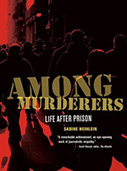Among Murderers: Life after Prison

Author: Sabine Heinlein
Publisher: Berkeley, CA: University of California Press, 2013. 256p.
Reviewer: Richard Tewksbury | May 2014
While at a recent conference I was in the book display room searching for a book to use in a graduate class. I wanted an interesting, contemporary, American-based study that I could present to students as an example of ethnographic field methods in criminal justice and criminology. I mentioned this to my friends (you never know where you might get a good recommendation) and somewhat to my surprise I received several quick recommendations to Heinlein’s Among Murderers: Life After Prison. I went to the publisher’s booth, told the representative the type of book for which I was looking, and he immediately picked up Among Murderers and told me “this is one of the best ethnographies you’ll find. I would definitely recommend it as a way to show students what ethnography is.” With both my friends and the publisher telling me this was the “perfect book” for me, of course I ordered a copy and put in my (already overdue) class book order.
As I have now read the book, I have to go back to my friends and explain to them that I was looking for a book that would both present ethnographic findings and provide a discussion of doing ethnographic research (e.g. methods). Unfortunately, Among Murderers does not achieve either of the goals I was looking for in a book. While I enjoyed – and for some purposes do recommend – Among Murderers, this is not a traditional ethnographic manuscript. What Heinlein has produced, and which she openly acknowledges as such, is a journalistic account of three formerly incarcerated murderers and their experiences in their first three years of re-entry. This is a book that introduces the reader to a set of important social issues and policies and the implications of law through the detailed examination of three men’s lives. The focus is on the men, as characters, and how they negotiate their lives while facing the same basic challenges and hurdles as one another. Yes, this is a “qualitative” book, but it is so in a rather non-social scientific manner.
Heinlein basically tells the stories of Angel, Adam and Bruce, three racially and generationally different men, while chronicling her social experiences with the three over a nearly three year period. Heinlein befriended the men, and over the course of three years visited them and accompanied them as they lived and worked at The Castle, a halfway house in West Harlem, founded by the Fortune Society. Heinlein gets to know the men as they adjust to life outside of prison, take varying approaches to adjusting to the experience of living in a halfway house, participate in (and eventually become disenchanted with) numerous public and private re-entry services, establish social and intimate relationships, pursue jobs and learn to manage the stigma of being a “murderer.” The label of “murderer” as a perpetual and nearly-impossible-to-overcome scarlet letter is a theme that permeates all three men’s stories. As such, witnessing the consequences of such a label on subjects with whom she becomes personally involved leads Heinlein to rail against labeling, as well as long-term incarceration — especially when it is devoid of truly rehabilitative programming.
What the reader gets is an indepth look at the experiences of re-entry, the struggles of long-term incarcerates to readjust to a new and different world than they left, and a look at how community resources work (or not) for such men. These stories, however, are largely without contextualizing or analysis. Recall, the author is a journalist, and presents her experiences in a journalistic fashion. Rather than “explanation” and analysis, Heinlein instead offers personal editorializing and “insights”. She argues against the structures, organizations and philosophies that seemingly both create and constantly reinforce the barriers and struggles of Angel, Adam and Bruce.
In some regards the journalistic presentation is one of the greatest benefits of Among Murderers, as the book is very easy to read. The prose flows well, the stories of each man draw the reader in, and the lives and experiences of each man is presented in a way that allows the reader to feel they know the men. There is a story here, and it is engaging and inviting to read. If used in a classroom (as I will soon do with it), this is sure to be well received by students. Issues are explained and information is taught, but through stories and an enjoyable reading experience.
Where the book falls short is in being an example of academic ethnography, despite being intended to be such. To non-ethnographers, especially quantitatively-oriented scholars and non-researchers, this is a book that will be perceived as “qualitative research” and “ethnography”, and may well serve to provide such audiences a positive predisposition to ethnographic work. Or, this may be a book pointed to by the critics of qualitative research as merely “a case study, or three”. Additionally, throughout the book Heinlein is present in her narrative, as she spends much of her time relating conversations with Angel, Adam, Bruce and others; and as an active participant in the conversations and interactions she recounts, she is as much a piece of the story as her subjects. But, although she is constantly present, little is known about her. The reader knows she is a journalist, born in Germany, and living in the United States for her adult years. Late in the book a husband is mentioned, but beyond these tidbits the reader is left to wonder who she is, and how her personality, presentation of self and styles of interacting are influencing the events and conversations she reports. The narrator is clearly present, yet a mystery figure of whom the reader knows very little. For these reasons the value of this book as an academic book can be debated. It makes a convincing case for the arguments of the author, but not in a scientific manner. The stories of Angel, Adam and Bruce are also unique (as are all individuals’ stories) in that all three men have lived their lives in New York City and New York prisons. Generalizability is absent, although the reader is likely to come away believing that these men’s experiences must certainly be representative of all criminally-similar others.
Where Among Murderers stands out as very valuable is as a tool for teaching about re-entry and the challenges of former inmates navigating the world upon release. As a means for teaching students that policies and initiatives are most important, depending on the level of their implementation and the experiences of those to whom they are applied, this is a great book. The presentation is thought-provoking, easily digested and because of the depth with which each of the three main men is introduced to the reader, also a very convincing presentation. Among Murders is informative, insightful and a pleasure to read. But, it is not ethnography.
Leslie Irvine,
University of Colorado at Boulder, irvinel@colorado.edu


